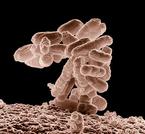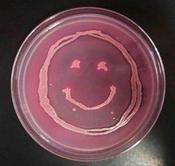 | ||||
Coliform Bacteria
and Fecal Contamination of Drinking Water
from Science Prof Online
Coliform bacteria are widely distributed, and can be found in the soil, on plants and in the lower gastrointestinal tract of animals and humans. These bacteria are a loosely-related group of Gram-negative, rod-shaped, lactose fermenters of the following genera: Escherichia, Enterobacter, Klebsiella, Serratia, Citrobacter,
and Proteus. Some are aerobic (oxygen requiring) others facultatively anaerobic (able to function without oxygen).
Article Summary: Coliforms are a group of Gram-negative bacteria commonly used as an indicator of possible fecal contamination of a water supply.
Contamination of Water with Coliform Bacteria
 | ||||
You have free access to a large collection of materials used in a college-level introductory microbiology course. The Virtual Microbiology Classroom provides a wide range of free educational resources including PowerPoint Lectures, Study Guides, Review Questions and Practice Test Questions.
Page last updated: 6/2014
SCIENCE PHOTOS
SPO VIRTUAL CLASSROOMS
Although most types of coliform bacteria are harmless, some species and strains can cause disease.
Total Coliforms and Fecal Coliforms
When water is tested for the presence of coliform bacteria, the investigators are looking for “total coliforms”, meaning any type of coliform bacteria, both harmless and pathogens. Their presence in water is an easy to assess indicator of environmental contamination, and warrants further, more specific water testing.
An important subset of the “total coliform” group are the “fecal coliforms”. The presence of fecal coliforms is evidence that that the water has recently been contaminated with feces, and that there is a higher risk of pathogenic bacteria being present. Fecal contamination of water can occur from many sources, including leaky septic tanks, farm runoff, or contaminated surface water leaking directly into a well or reservoir.
Testing for Coliform Bacteria
Since all coliforms can ferment (eat) the sugar lastose, their presence is easy to test for in a microbiology lab, using a differential bacterial growth medium such as MacConkey’s agar, on which coliforms will grow in pink bacterial colonies. Test kits are also available, in which the water sample can be collected, bacteria (if present) incubated and grown, and presence of coliforms indicated by a visible color change in the sample.
Municipal water supplies are regularly tested for coliform bacteria, but for people whose water comes from a well, annual testing is advised, as well as testing after heavy rainstorms (when a well may have flooded), or after a well has been opened for maintenance or repair. To find out more about having your water tested, contact your local health department or a Department of Environmental Quality (DEQ) District Field Office.
Sources & Resources
- Bauman, R. (20014). Microbiology with Diseases by Taxonomy, 4th ed., Pearson Benjamin Cummings.
- Department of Environmental Quality, State of Michigan. “Quality of Water and Well-water Sampling."
- Perry, J. and Stanley, J. (1997) Microbiology Dynamics & Diversity. Saunders College Publishing.
- Treyens, C. (2009). “Bacteria and Private Wells: Information Every Well Owner Should Know.” National Ground Water Association.
- University of Illinois Extension, “Test Your Water for Coliform Bacteria and Nitrate.”
Coliform bacteria, E. coli, growing on MacConkey's Agar. Pink color of bacteria indicates that it is a lactose fermenter.
VIDEO: How to Interpret MacConkey's Agar (MAC) Bacterial Growth Medium




